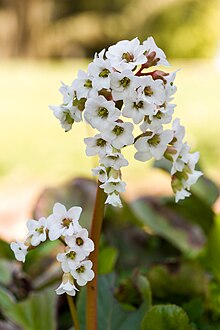Bergenia
| Bergenia | |
|---|---|

| |
| Bergenia cordifolia | |
| Scientific classification | |
| Kingdom: | Plantae |
| Clade: | Tracheophytes |
| Clade: | Angiosperms |
| Clade: | Eudicots |
| Order: | Saxifragales |
| Family: | Saxifragaceae |
| Genus: | Bergenia Moench(1794), nom. cons. |
| Species[1] | |
|
10; see text | |
| Synonyms[1] | |
| |
Bergenia/bərˈɡɛniə/[2](elephant-eared saxifrage,elephant's ears) is agenusof tenspeciesofflowering plantsin thefamilySaxifragaceae,nativeto central Asia, from Afghanistan to China and the Himalayan region.
Description
[edit]They are clump-forming,rhizomatous,evergreenperennialswith a spirally arranged rosette of leaves 6–35 cm long and 4–15 cm broad, and pink flowers produced in acyme.[3]The leaves are large, leathery,ovateor cordate, and often have wavy or saw-toothed edges. For most of the year, the leaves have a glossy green colour, but in cooler climates, they turn red or bronze in the fall. The flowers grow on a stem similar in colour to arhubarbstalk and most varieties have cone-shaped flowers in varying shades of pink. These can range from almost white to ruby red and purple.[4]
The common names forBergeniaare pigsqueak (due to the sound produced when two leaves are rubbed together), elephant's ears (due to the shape of the leaves) and large rockfoil.
Bergeniais closely related toMukdenia,Oresitrophe,AstilboidesandRodgersia.
The creator of the taxonomic genus name,Conrad Moench,honoured the German botanist and physicianKarl August von Bergenby coining the nameBergeniain 1794.
Species
[edit]
10 species are accepted.[1]
- Bergenia ciliata(Haw.) Sternb.– western Himalayas to southwestern Nepal. Has cultivarBergenia ciliata'Superba'.
- Bergenia crassifolia(L.) Fritsch(syn.Bergenia cordifolia) – Kazakhstan and western Siberia to Mongolia, the Russian Far East, and Korea. The most widely grown garden plant, especially the cultivarBergenia cordifolia'Purpurea.' The species epithetcrassifoliameans thick-leaved, andcordifoliameans cordate (heart-shaped) leaf (although the leaves may also be described as spoon-shaped). It grows to about 30 cm tall. The leaves are winter hardy and change color in the range of rust brown to brown-red. Other cultivars areBergenia cordifolia'Winterglut',Bergenia cordifolia'Senior', andBergenia crassifolia'Autumn Red'.
- Bergenia emeiensisC.Y.Wu ex J.T.Pan– centralSichuanprovince of south-central China
- Bergenia hissaricaBoriss.– west Hisiar in Uzbekistan
- Bergenia pacumbis(Buch.-Ham. ex D.Don) C.Y.Wu & J.T.Pan(synonymBergenia ligulataEngl.) – eastern Afghanistan to the Himalayas, Myanmar, and south-central China (western Yunnan).
- Bergenia purpurascens(Hook.f. & Thomson) Engl.– central Himalayas to Myanmar and south-central China (southwestern Sichuan and northern Yunnan). 30 – 40 cm tall with carmine-red flowers. Leaves are oval-shaped.
- Bergenia purpurascensvar.delavayiis ca. 50 cm tall with small leaves and rosy red flowers.
- Bergenia scopulosaT.P.Wang– southernShaanxiProvince of central China
- Bergenia stracheyi(Hook.f. & Thomson) Engl.– eastern Afghanistan to Tajikistan, southwestern Tibet, and Nepal. Has cultivarsBergenia stracheyi'Alba' andBergenia stracheyi'Afghanica'
- Bergenia tianquanensisJ.T.Pan– central Sichuan Province in China
- Bergenia ugamicaV.N.Pavlov– eastern Uzbekistan
Cultivation
[edit]Bergeniaarehardyplants that can grow in climates with extreme temperature ranges from about −35 °F (−37 °C) to 115 °F (46 °C). They prefer sun but will grow in shady areas as well. Plants can grow to about 24 in (61 cm) tall and 24 in (61 cm) wide. They do well in most soils, but moist, humus-rich soil is preferable. Exposure and dry soils tend to stunt growth, but can enhance the winter leaf colours. In areas with cold, strong winter winds, protection from the wind may be required.[4]They arepropagatedby division or rooted rhizome sections.[3]

Bergenia crassifolia,Bergenia cordifolia,and various hybrids are often grown in gardens, with severalcultivarsselected.
The following cultivars have gained theRoyal Horticultural Society'sAward of Garden Merit:-
- B. cordifolia'Rosa Zeiten'[5]
- B. purpurascens[6]
- B. purpurascensvar.delavayi[7]
- 'Biedermeier'[8]
- 'Bressingham White'[9]
- 'Britten'[10]
- 'Claire Maxine'[11]
- 'Eden's Magic Giant'[12]
- 'Eric Smith'[13]
- 'Eroica'[14]
- 'Frau Holle'[15](pale pink)
- 'Sunningdale'[16]
- 'Irish Crimson'[17]
- 'Morgenröte'[18]
- 'Pugsley's Pink'[19]
- 'Silberlicht'[20]
- 'Wintermärchen'[21]
Pests and diseases
[edit]Bergenia are robust plants and generally free of problems, althoughvine weeviladults readily eat the edges of the leaves, resulting in an indented, 'notched' outline which can detract from the appearance of the plant.
Uses
[edit]Bergenin,C-glycoside of 4-O-methylgallic acid,and its O-demethylated derivativenorbergenin,are chemical compounds and drugs ofAyurveda,commonly known as Paashaanbhed. They can be isolated fromBergenia ciliataandBergenia ligulata[22]and from rhizomes ofBergenia stracheyi.It shows a potentimmunomodulatoryeffect.[23]
References
[edit]- ^abcBergeniaMoench.Plants of the World Online.Retrieved 13 April 2024.
- ^Sunset Western Garden Book,1995:606–607
- ^abRHS A-Z encyclopedia of garden plants.United Kingdom: Dorling Kindersley. 2008. p. 1136.ISBN978-1405332965.
- ^ab"Guide to Growing Bergenia Plants".The Garden Helper.Retrieved2009-06-30.
- ^"Bergenia cordifolia'Rosa Zeiten'".RHS.Retrieved12 April2020.
- ^"Bergenia purpurascens".RHS.Retrieved12 April2020.
- ^"Bergenia purpurascensvar.delavayi".RHS.Retrieved12 April2020.
- ^"Bergenia'Biedermeier'".RHS.Retrieved12 April2020.
- ^"Bergenia'Bressingham White'".RHS.Retrieved12 April2020.
- ^"Bergenia'Britten'".RHS.Retrieved12 April2020.
- ^"Bergenia'Claire Maxine'".www.rhs.org.Royal Horticultural Society.Retrieved12 April2020.
- ^"Bergenia'Eden's Magic Giant'".RHS.Retrieved12 April2020.
- ^"Bergenia'Eric Smith'".RHS.Retrieved12 April2020.
- ^"Bergenia'Eroica'".RHS.Retrieved12 April2020.
- ^"Bergenia'Frau Holle'".RHS.Retrieved12 April2020.
- ^"Bergenia'Sunningdale'".RHS.Retrieved12 April2020.
- ^"Bergenia purpurascens'Irish Crimson'".RHS.Retrieved12 April2020.
- ^"Bergenia'Morgenröte'".RHS.Retrieved12 April2020.
- ^"Bergenia'Pugsley's Pink'".RHS.Retrieved12 April2020.
- ^"Bergenia'Silberlicht'".RHS.Retrieved12 April2020.
- ^"Bergenia'Wintermärchen'".RHS.Retrieved12 April2020.
- ^Simultaneous quantification of bergenin, catechin, and gallic acid from Bergenia ciliata and Bergenia ligulata by using thin-layer chromatography. Dhalwal K., Shinde V.M., Biradar Y.S. and Mahadik K.R., 2008,INIST20528090
- ^Immunomodulatory effect of bergenin and norbergenin against adjuvant-induced arthritis—A flow cytometric study Nighat Nazira, Surrinder Koulb, Mushtaq A. Qurishia, Sachin C. Tanejab, Sheikh F. Ahmadc, Sarang Banic and Ghulam N. Qazi, 2006
